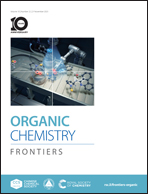Fundamental difference between simple arenes and PAHs found in o-PAH-connected porphyrins†
Abstract
o-PAH-connected porphyrins (4a and 4b) were synthesized as extended forms from aromatic o-benzene(pyridine)-connected porphyrin (3a (3b)), wherein naphthalene and anthracene motifs were employed for extension. Notably, the naphthalene and anthracene versions (4a and 4b) were nearly non-aromatic. The ring current property of 4a and 4b should match aromatic 3a due to minimal (or no) additional steric hindrance. Hence, the reduced aromaticity might stem from the distinct natures of simple arenes and PAHs. The significantly diminished aromaticity of 4a and 4b was confirmed by their 1H NMR spectra and supported by the X-ray structure of 4a, along with the weighted average NICS (0) values from conformers and tautomers at equilibrium. Differences arise from diverse FMOs of simple arenes and PAHs. As the size of PAHs increases, their FMOs become denser in the middle and less prominent at the edges. Consequently, the character of the ring current is dictated by the newly formed bonds at the edges of arenes. These effects were observed for the first time in this study. Furthermore, our findings were applied to meso-arenoporphycene (9) and predicted reduced aromaticity with PAHs replacing benzene.



 Please wait while we load your content...
Please wait while we load your content...